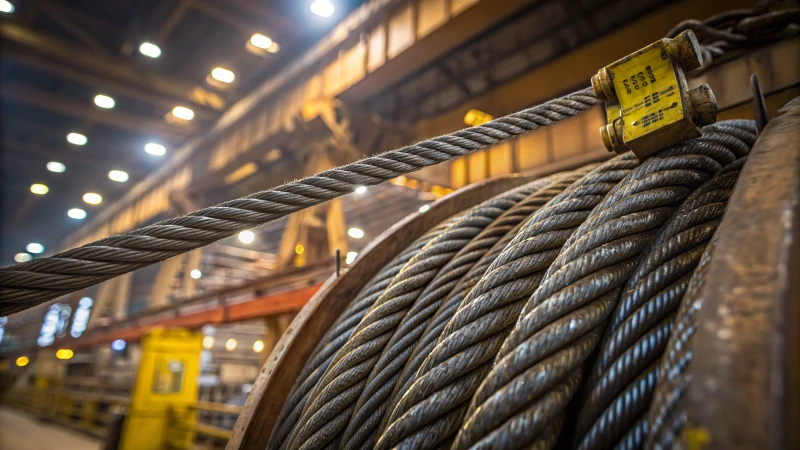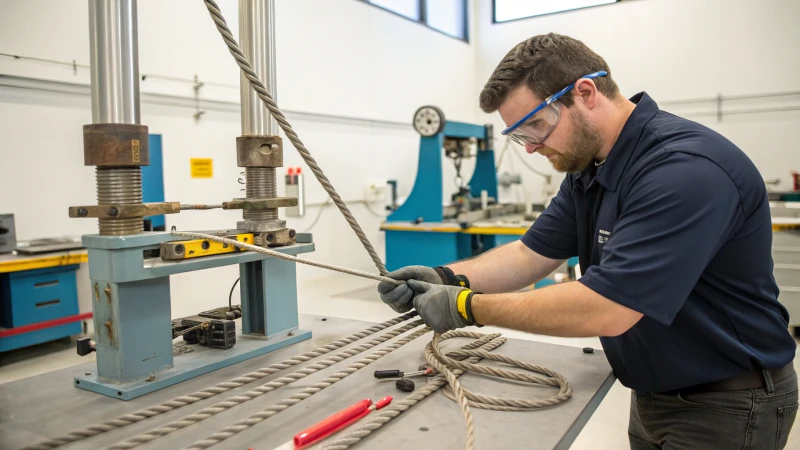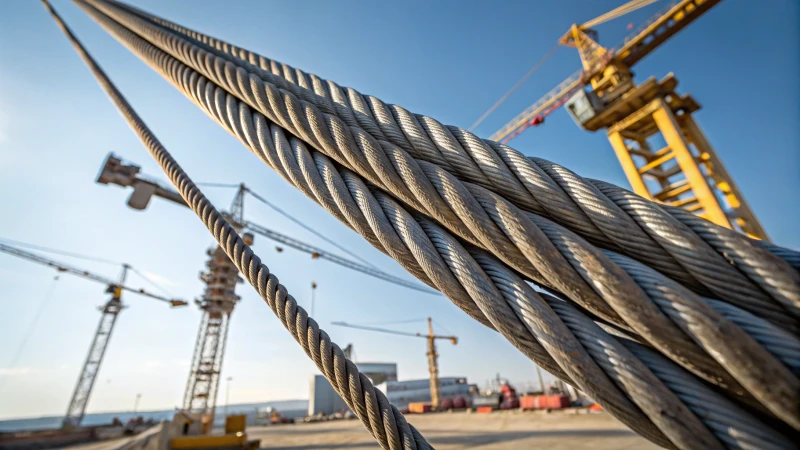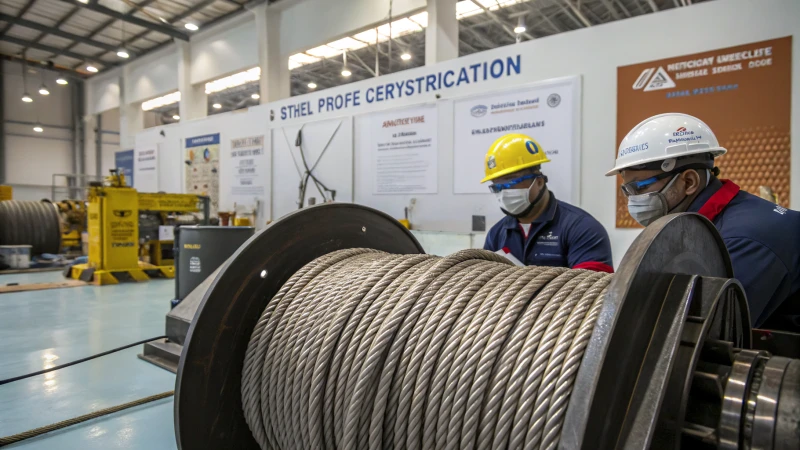
Navigating crane safety standards can feel like an uphill battle, but it's crucial for smooth operations.
Crane steel wire ropes must meet safety standards such as ISO 4309 and EN 12385 to ensure they are safe and reliable. These certifications confirm that ropes adhere to strict industry regulations, assuring their quality, durability, and performance under pressure.
When I first delved into the world of crane operations, understanding the layers of certification felt overwhelming. But knowing these standards not only reassures me about product safety but also helps me make informed procurement decisions. Let's unpack these standards further to empower procurement managers with the knowledge needed to navigate this complex landscape.
Crane wire ropes must comply with ISO 4309 standards.True
ISO 4309 is a key standard ensuring the safety of crane wire ropes.
EN 12385 certification is optional for crane wire ropes.False
EN 12385 is mandatory for ensuring crane wire rope safety and reliability.
Why Is ISO 4309 Important for Steel Wire Ropes?
You know, working with steel wire ropes often feels like handling the backbone of any project. It's the unsung hero ensuring everything runs smoothly and safely.
ISO 4309 is crucial because it lays down the rules for inspecting, maintaining, and retiring steel wire ropes used in lifting gear, safeguarding both safety and regulatory compliance.

Understanding ISO 4309
Let me tell you, when I first dove into the world of steel wire ropes, ISO 4309 was like this guiding light. It’s an international standard that’s all about how to properly inspect and maintain those ropes we rely on for heavy lifting. From the nitty-gritty of visual inspections to knowing exactly when to retire a rope, it ensures that safety isn’t just a buzzword but a reality. If you're like me and work in industries such as construction or mining, you know these guidelines are more than just paperwork—they're lifesavers.
Key Components of ISO 4309
- Inspection Procedures: Honestly, regular inspections are like our routine health check-ups. They’re essential to spot any wear and tear or corrosion early on.
- Maintenance Guidelines: Think of these as your go-to manual for extending a rope's life, covering lubrication and protection against the elements.
- Discard Criteria: This part is crucial; it tells you when it's time to let go of a rope that's past its prime, thanks to damage or wear.
I can’t stress enough how important it is to catch potential issues early to prevent any major disasters.
| Component | Description |
|---|---|
| Inspection | Visual checks and measurements for damages |
| Maintenance | Regular lubrication and cleaning |
| Discard Criteria | Guidelines for retiring ropes based on wear and damage |
Real-World Applications
In real-world settings, industries like construction1 and mining2 adhere to ISO 4309 not just to tick a box but to ensure safety in every operation. Just imagine cranes using steel wire ropes—failure isn’t an option because the risks are too high. Similarly, in mining, ropes are pushed to their limits by extreme conditions, so they need to be tip-top without compromising safety.
Steel wire ropes are out there battling wear and the environment every day. Regular inspections aren’t just a good idea; they’re necessary. For procurement officers like us, choosing ropes that meet compliance standards is not just about safety—it’s about making sure we’re getting our money’s worth in durability and longevity. For instance, procurement managers3 in mining often opt for suppliers who strictly follow ISO 4309.
By adhering to ISO 4309, companies not only comply with safety regulations but also extend the lifespan of their equipment, which saves costs over time. Knowing these guidelines aids us in picking quality ropes and keeping them in prime condition.
ISO 4309 mandates regular steel wire rope inspections.True
ISO 4309 requires routine checks to identify wear or damage, ensuring safety.
ISO 4309 does not cover discard criteria for ropes.False
ISO 4309 includes guidelines on when to retire ropes based on wear and damage.
How do EN 12385 standards impact crane operations?
Ever wondered how a simple set of guidelines can transform a crane's reliability and safety?
EN 12385 standards significantly impact crane operations by setting precise criteria for the design, testing, and maintenance of steel wire ropes. These guidelines ensure the ropes' strength, flexibility, and environmental resilience, which are vital for safe and efficient crane functioning.

Understanding EN 12385 Standards
Let me take you back to my first project as a procurement manager. I was tasked with sourcing steel wire ropes for a major construction site. As I dove into the specifications, the EN 12385 standards stood out like a lighthouse guiding me through turbulent waters. These standards are more than just technical jargon—they're the backbone of ensuring our ropes can handle the pressures and demands of crane operations safely and reliably.
Key Components of EN 12385
- Tensile Strength: Picture this—it's like ensuring your favorite climbing rope won't snap when you're halfway up the cliff. The minimum tensile strength outlined in the standards guarantees that the ropes can handle the load stress during crane activities4.
- Elongation and Elasticity: Remember stretching a rubber band as a kid? Now imagine it holding a steel beam instead. The standards specify how much elongation is permissible so that ropes maintain their integrity under stress.
- Resistance to Environmental Factors: Think of the ropes as soldiers facing harsh climates in construction and mining operations5. They must resist corrosion, temperature changes, and wear, making them durable under tough conditions.
| Component | Specification |
|---|---|
| Tensile Strength | Minimum tensile strength per rope type |
| Elongation | Permissible elongation limits |
| Corrosion Resistance | Must withstand specific environmental conditions |
Implications for Crane Operations
Adhering to these standards isn't just about ticking a compliance box; it's about creating a safer workplace. I recall discussing this with John, a seasoned construction manager who shared how using certified ropes reduced downtime significantly. This kind of foresight enhances not only safety but also efficiency.
- Safety Compliance: These standards ensure that operations align with legal requirements6, minimizing accident risks.
- Operational Efficiency: Ropes that meet EN 12385 bear higher loads with less wear, boosting productivity.
- Cost Implications: Initially pricey, compliant ropes pay off by cutting maintenance costs and extending lifespan.
Challenges in Implementation
The road to implementing these standards isn't always smooth. Initial investments in compliant materials can be steep, and training staff on maintenance is crucial. Suppliers must consistently deliver products meeting these specifications. But here's where it gets interesting: it's all about building partnerships with suppliers who understand these needs and offer robust after-sales support.
For folks like John or Emma, getting a handle on these standards is more than a professional necessity—it's about ensuring every project runs like a well-oiled machine, safely and efficiently. Building strong supplier relationships is essential for achieving this.
EN 12385 standards ensure ropes withstand crane operational loads.True
The standards specify tensile strength to handle crane loads safely.
Adhering to EN 12385 decreases crane operation downtime.True
Certified ropes reduce failures, minimizing downtime in operations.
What Are the Latest Trends in Steel Wire Rope Certification?
Imagine walking into a construction site and knowing every steel wire rope meets the highest standards. That's the future of certification.
The latest trends in steel wire rope certification emphasize heightened safety standards, technological innovation, and global standardization, ensuring ropes meet varied industry needs with enhanced durability and compliance.

Emphasis on Enhanced Safety Standards
Safety is more than just a checkbox—it's a lifeline. I remember when my team had to halt a project because the steel wire ropes we sourced didn't meet the updated ISO 4309 standards. It was a wake-up call. Now, industry bodies are pushing for stricter guidelines, including maintenance and discard criteria, to reduce risks in challenging environments. This change is crucial for us who work in high-stakes sectors like construction and mining, where the integrity of every component can impact lives.
| Standard | Key Updates |
|---|---|
| ISO 4309 | Updated maintenance guidelines |
| EN 12385 | Improved discard criteria |
Integration of Smart Technologies
Tech isn't just transforming our personal lives; it's reshaping how we approach industrial tasks. Picture this: smart sensors and IoT devices on steel wire ropes, providing real-time data about their performance. This isn't just futuristic—it’s happening now. I once had to rely on guesswork and periodic checks; now, this technology offers certainty. Procurement managers like John can make informed decisions7 about replacements before a problem escalates.
Global Harmonization Efforts
Working across borders used to mean juggling different standards. I recall the frustration of dealing with multiple sets of regulations. Thankfully, there's a move towards global harmonization of certifications like ISO and EN, smoothing out these differences. This is a game-changer for procurement officers like Emma, who need uniformity and quality assurance across their supply chains. It's not just about simplifying paperwork—it's about ensuring safety and efficiency no matter where you're operating.
Efforts to align standards also focus on reducing bureaucratic hurdles, allowing for smoother transitions between international markets8.
The Role of Environmental Considerations
Sustainability isn't just a buzzword; it's becoming a business imperative. I’ve seen manufacturers adapt by using recyclable materials and lowering their carbon footprints. This isn't just good for the planet—it's aligning with our goals at WonBon to offer sustainable solutions9. It's about being responsible today for a better tomorrow.
Industry-Specific Certifications
Specialized needs require specialized solutions. For example, in the marine sector, ropes must withstand corrosive saline environments. I once struggled with generic certifications that didn’t account for these nuances. Now, industry-specific certifications ensure that products like those used by Raj meet stringent industry requirements10. These evolving trends in steel wire rope certification reflect a dynamic shift towards meeting modern industrial demands with precision and care.
ISO 4309 now includes IoT integration guidelines.False
ISO 4309 updates focus on safety and maintenance, not IoT integration.
Global harmonization reduces trade barriers for steel wire ropes.True
Aligning standards like ISO and EN facilitates smoother international trade.
How Do Procurement Managers Like Me Ensure Compliance with Safety Regulations?
Navigating the maze of safety regulations is a real challenge, but it's one I embrace with passion and determination. Compliance isn't just a checklist for me—it's about creating a safe and secure work environment.
Procurement managers like me can ensure compliance with safety regulations by weaving risk management into our procurement processes, choosing certified suppliers, conducting routine audits, and championing thorough training programs.

Integrating Risk Management into Procurement
In my world, risk management is more than a buzzword—it's a lifeline. Before diving into procurement, I make it a point to conduct thorough risk assessments11. This helps me pinpoint potential safety hazards lurking in the supply chain. I delve into suppliers' compliance histories and scrutinize product certifications like ISO 4309 for steel wire ropes. This way, I know I'm aligning with industry standards right from the start.
Selecting Certified Suppliers
Choosing the right suppliers is like building a team—it's about trust and shared values. I seek out suppliers who not only meet industry standards but also exceed them. Certified products that adhere to international safety regulations, such as EN 12385, are non-negotiables for me. This commitment not only ensures compliance but also significantly reduces the risk of accidents.
| Supplier | Certification | Industry |
|---|---|---|
| Supplier A | ISO 4309 | Construction |
| Supplier B | EN 12385 | Mining |
Conducting Regular Audits
Regular audits are my version of a safety net. Establishing a routine inspection schedule allows me to review both documentation and the physical condition of products. This proactive approach means I can catch non-compliance issues before they escalate, effectively minimizing risks.
Implementing Training Programs
Training isn't just a requirement—it's an investment in peace of mind. I ensure my team is always up-to-date with the latest safety standards and regulations. This includes everything from understanding product specifications12 to navigating supplier negotiations with a keen eye on safety.
Leveraging Technology for Compliance
Technology has become my compliance companion. By using procurement software solutions, I can automate tracking supplier certifications, audit schedules, and regulatory updates. This ensures that no detail slips through the cracks.
By embedding these practices into my procurement strategies, I not only ensure compliance but also foster a culture of safety that prioritizes everyone's well-being—from my team to the end-users.
Risk assessments identify supply chain safety hazards.True
Risk assessments help identify potential safety hazards in the supply chain.
Procurement software cannot track supplier certifications.False
Procurement software can automate tracking of supplier certifications.
Conclusion
Crane steel wire ropes must comply with ISO 4309 and EN 12385 standards to ensure safety, reliability, and performance in heavy lifting operations across various industries.
-
Learn how ISO 4309 is applied in the construction industry to enhance crane safety and operational efficiency. ↩
-
Discover why ISO 4309 is crucial for maintaining safety in mining operations involving steel wire ropes. ↩
-
Understand how procurement managers benefit from ISO 4309 when selecting steel wire ropes. ↩
-
Understand how these standards directly influence crane safety and performance. ↩
-
Learn how ropes withstand harsh conditions in mining environments. ↩
-
Explore the legal implications and requirements for maintaining crane operation safety. ↩
-
Learn about smart sensors transforming steel wire rope monitoring and decision-making. ↩
-
Explore the benefits of harmonized global standards for international trade efficiency. ↩
-
Find out how sustainability is influencing steel wire rope manufacturing processes. ↩
-
Understand the unique certification requirements for marine industry applications. ↩
-
Learn how to effectively conduct risk assessments in procurement to prevent potential safety issues. ↩
-
Discover methods for assessing product specifications to ensure they meet required safety standards. ↩

